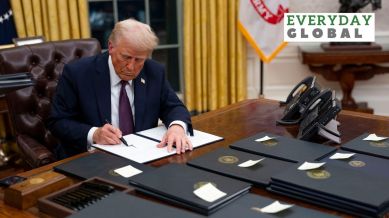Trump signs more than 80 orders on Day 1: What is an executive order?
Through his executive orders on Monday, Trump declared a national emergency at the US border with Mexico and ended birthright citizenship. How exactly do such orders work? We explain.

Donald Trump Executive Orders on Day 1: US President Donald Trump returned to the White House on Monday (January 20) issuing a barrage of executive orders and repealing multiple directives by the previous administration.
He signed as many as 80 executive orders by 9 pm local time, declaring a national emergency at the US border with Mexico, withdrawing from the Paris Agreement and the World Health Organisation (WHO), and ending birthright citizenship.
How exactly do such orders allow for policies to be implemented? Can they be legally challenged? We explain.
What is an executive order?
The American Bar Association defines an executive order as a “signed, written and published directive from the President of the United States that manages operations of the federal government.”
The president enjoys the authority to issue such orders under Article II of the US Constitution, which says “The executive power shall be vested in a president of the United States of America.” Article II establishes the post of president and lays out his powers, including as Commander-in-Chief of the military, as well as the power to grant pardons and commute sentences.
Executive orders are consecutively numbered for reference and published in the Federal Register, the daily journal of the federal government that details federal regulations and actions. The register further contains proclamations and administrative orders, also issued by the president. While proclamations convey information on holidays, commemorations, federal observances and trade, administrative orders deal with specific administrative matters of the federal government.
Both executive orders and proclamations enjoy the force of the law, similar to regulations issued by federal agencies.
What is the impact of an executive order?
An executive order may take effect immediately or within a few months, depending on it needing support in its implementation from a federal agency. For example, in 2022, Biden ordered health agencies to institute safeguards to access abortion after the US Supreme Court overturned Roe v Wade (a case that resulted in constitutional protection for the right to have an abortion). Over the following months, agencies passed regulations to this effect, including a rule protecting the privacy of people who obtain abortions.
In keeping with the separation of powers among the executive, legislature and judiciary, the President cannot make new laws through an executive order.
Can executive orders be legally challenged?
Executive orders do not require Congressional approval as they are not legislation. They cannot be directly overturned by Congress: only a sitting US President can overturn an existing executive order by issuing another.
However, an order may be subject to judicial review if it appears to violate constitutional principles or exceeds the president’s authority. When Trump came to power in 2017 for his first presidential term, he signed an order for a temporary travel ban, restricting people from seven Muslim-majority countries from coming to the US. However, a federal court stayed portions of the order, though it was subsequently upheld by the US Supreme Court in 2018.
Trump’s executive order on Monday to establish an advisory body called the Department of Government Efficiency (DOGE), headed by billionaire Elon Musk, has already drawn legal challenges. Musk has previously outlined agendas such as dramatically cutting funds for government agencies and reducing the number of employees. According to Reuters, government employee unions, watchdog groups, and public interest organisations sued within minutes of the announcement.
In some cases, Congress may choose to pass legislation to override the executive order, and can refuse to provide the necessary funding to implement the policy measures it entails. But such legislation can still be vetoed by the president.
How have executive orders been used in the past?
Executive orders officially date back to Abraham Lincoln’s term as president (1861-65), when he issued the “Executive Order Establishing a Provisional Court in Louisiana” in October 1862.
Presidents before him issued official directives that can be recognised as executive orders today. Every president, barring William Henry Harrison, has passed executive orders in some capacity. The longest-serving president Franklin D Roosevelt (1933-45) issued a whopping 3,721 orders. Woodrow Wilson and Calvin Coolidge signed 1,803 and 1,203 respectively.
Trump signed 220 executive orders in his first term.